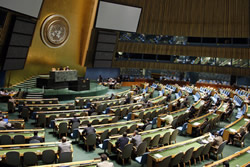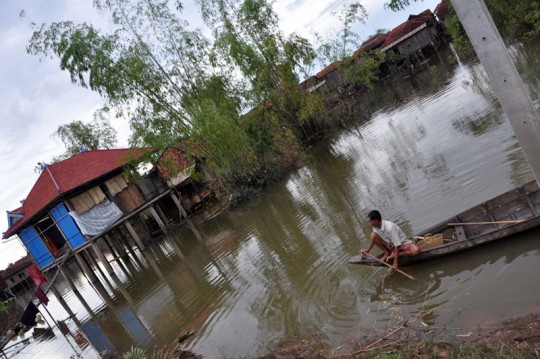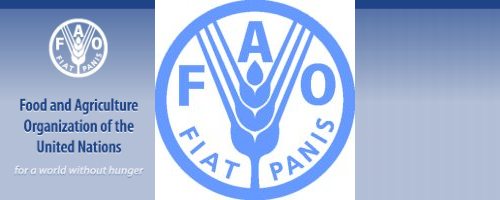UN agencies voice concern at impact of South-East Asian floods on children
UN agencies voice concern at impact of South-East Asian floods on children
The floods – a result of heavy seasonal rains and frequent cyclones – have affected eight million people across Cambodia, Laos, the Philippines, Thailand and Viet Nam.
To date, 745 people are reported dead as a result of the flooding, including over 200 children. In Cambodia alone, 80 children have died, mostly from drowning.
According to the UN Children’s Fund (UNICEF), the most urgent needs for children are clean water, hygiene supplies to prevent the spread of disease, food supplies and safe places in evacuation centres for children to play. The agency is working with the affected governments and partners to provide immediate assistance to those who need it most.
The World Food Programme (WFP) said it is launching an emergency operation to address the immediate food needs of some 12,000 households, or 60,000 people, in Cambodia with distributions of monthly rations of rice set to begin in the coming days.
The main aim of the $500,000 emergency operation was to save lives and protect livelihoods by averting damaging coping mechanisms which were already being adopted by affected households, according to the agency. These included borrowing rice at very high interest rates, selling assets, pulling children out of school, and reducing food intake.
In many of the affected countries, the school year was scheduled to begin this month, the agency noted. However, massive damage to school infrastructure and supplies will mean hundreds of thousands of children may miss weeks or months of school.
Over 1,300 schools in Cambodia, or 17 per cent of the total, are affected by the floods. Roughly 75 per cent of these schools were not able to open for the new academic year on 1 October, affecting 455,000 children. In Thailand, over 3,000 educational institutions have been affected.
The UN International Strategy for Disaster Reduction (UNISDR) also voiced their concern at the many children who have died as a result of the floods, as well as the thousands of workers unemployed because of poorly located manufacturing plants.
It is urging the affected governments to open discussions with the private sector on what adjustments need to be made in their land use to locate their factories in disaster-proof areas to better protect their workers and prevent them from building their homes in unsafe areas.
Across the region, the well-being of millions would be drastically affected by the loss of livelihoods, as manufacturing plants were forced to shut and agriculture struggled to recover, ISDR noted.
While precise figures are not yet available, the floods are estimated to have damaged over three million hectares of cropland across the region. In addition, loss of livestock and poultry is reported and significant numbers are considered to be at risk, according to a report released by the Food and Agriculture Organization’s (FAO) Global Information and Early Warning System.
###
> UN Food and Agriculture Organization (FAO).
The Food and Agriculture Organization of the United Nations (FAO) is an intergovernmental organization and has 191 Member Nations, two associate members and one member organization, the European Union. Achieving food security for all is at the heart of FAO’s efforts – to make sure people have regular access to enough high-quality food to lead active, healthy lives.

FAO’s mandate is to raise levels of nutrition, improve agricultural productivity, better the lives of rural populations and contribute to the growth of the world economy.
The Food and Agriculture Organization of the United Nations (FAO) is working with its Members and the entire international community for achievement of the Millennium Development Goals.
These eight goals – each with specific targets and indicators – are based on the United Nations Millennium Declaration, signed by world leaders in September 2000. They commit the international community to combating poverty, hunger, disease, illiteracy, environmental degradation, and discrimination against women.
![]()
The eight Millennium Development Goals are:
Goal 1: Eradicate extreme poverty and hunger
Goal 2: Achieve universal primary education
Goal 3: Promote gender equality and empower women
Goal 4: Reduce child mortality
Goal 5: Improve maternal health
Goal 6: Combat HIV/AIDS, malaria and other diseases
Goal 7: Ensure environmental sustainability
Goal 8: Develop a Global Partnership for Development
* More information at UN Food and Agriculture Organization (FAO)
###
###
> United Nations (UN).
 The United Nations was established on 24 October 1945 by 51 countries committed to preserving peace through international cooperation and collective security. Today, nearly every nation in the world belongs to the UN: membership totals 192 countries.
The United Nations was established on 24 October 1945 by 51 countries committed to preserving peace through international cooperation and collective security. Today, nearly every nation in the world belongs to the UN: membership totals 192 countries.
When States become Members of the United Nations, they agree to accept the obligations of the UN Charter, an international treaty that sets out basic principles of international relations. According to the Charter, the UN has four purposes:
- to maintain international peace and security;
- to develop friendly relations among nations;
- to cooperate in solving international problems and in promoting respect for human rights;
- and to be a centre for harmonizing the actions of nations.
###
* The above story is adapted from materials provided by United Nations (UN)
** More information at United Nations (UN)






















